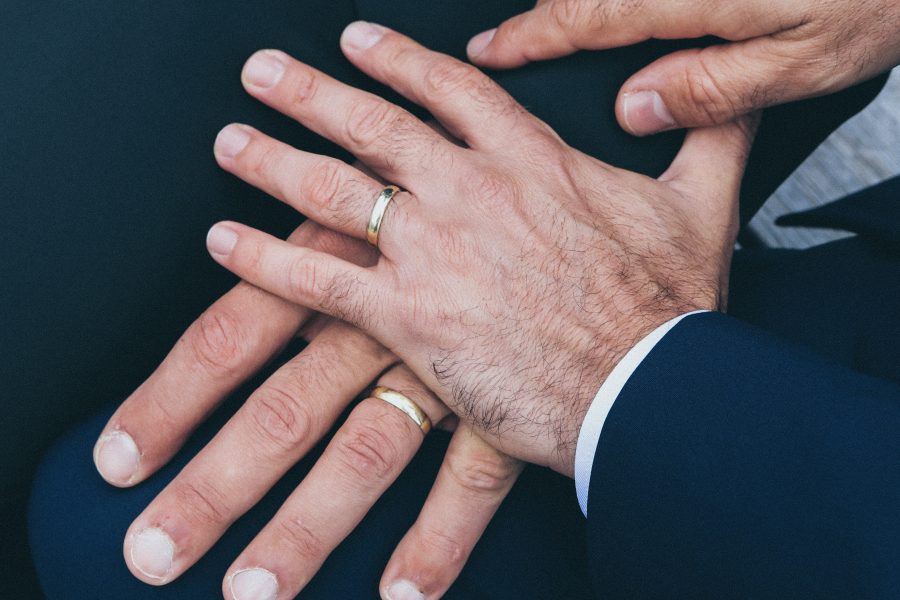
After the legalization of same-sex marriage in the U.S., more gay men reported having health insurance, access to medical care and annual checkups, according to a June 2018 working paper from the National Bureau of Economic Research.
The research, conducted by a team of scholars at Vanderbilt University, looks at marriage status and health outcomes for couples living in same-sex households before and after the legalization of same-sex marriage. A great deal of research suggests that married individuals are healthier than unmarried individuals, though less work focuses on the health of same-sex couples who are married, in part because of the recency of same-sex marriage legalization.
Same-sex marriage was legalized nationwide in 2015 per the Supreme Court’s ruling in Obergefell v. Hodges. Prior to this decision, it was legalized in a number of states, beginning with Massachusetts in 2004.
Lead author Christopher Carpenter, professor of economics at Vanderbilt University, described the study as the first of its kind to use a large sample of data on sexual minorities across the U.S. both before and after the legalization of same-sex marriage at the state and federal level.
Prior to the study, there weren’t preexisting data sets “that included the outcomes we wanted and sexual orientation before and after same-sex marriage legalization,” he explained in a phone interview with Journalist’s Resource.
So, Carpenter and his team devised a creative approach to get the data. They looked at survey responses collected from 2000 to 2016 through the U.S. Centers for Disease Control and Prevention’s Behavioral Risk Factor Surveillance System (BRFSS). In recent years the telephone surveys included responses from over 400,000 adults.
Part of the survey, which is conducted on the state-level to collect a sample meant to be representative of each state, asks respondents to describe the composition of their households. The researchers hypothesized that some households with exactly two men and some households with exactly two women would be gay and lesbian couples.
Beginning in 2014, the BRFSS included a question about sexual orientation for respondents in some states. Looking at data collected between 2014 and 2016, the researchers found that 11 percent of women and 27.8 percent of men in same-sex households with only two adults identified as something other than heterosexual. The authors assumed these pairs are “likely in a same-sex relationship.”
The assumption is strengthened by a contrasting example: in households occupied by one man and one woman, virtually none of these individuals identified as lesbian or gay, and only around 1 percent identified as anything other than heterosexual. Opposite-sex households of two in which the respondent reported being married were even less likely to have occupants identify as anything other than heterosexual. The authors write that these findings offer “strong evidence that household structure conveys meaningful information about a correlate of sexual orientation.”
The researchers estimated that between 11-28 percent of people in two-person same-sex households were sexual minorities and then turned their attention to two areas of interest for this group: marriage rates and health outcomes.
They found:
- After same-sex marriage was legalized, the researchers found increases in the number of individuals in same-sex households who were married.
- Overall, they estimate that for non-heterosexual women, legalization of same-sex marriage leads to “a 37 percentage point increase in marriage take-up.” For non-heterosexual men, they estimate a 21 percentage point increase.
- Further, the researchers found that men in same-sex households enjoyed improved health outcomes after the legalization of same-sex marriage. Women in same-sex households did not experience improved health outcomes. “We find consistent evidence for men in same-sex households that legal access to same-sex marriage not only increased marriage take-up but also significantly increased health insurance coverage, access to healthcare and utilization of checkups,” they write.
- The probability a man in a same-sex household reported being insured increased by 4.2 percentage points, the likelihood he reported a usual source of care also increased by 4.2 percentage points and the likelihood he had a medical checkup in the past year increased by 7.3 percentage points.
Carpenter suggested a few explanations for this phenomenon, including the fact that after the legalization of same-sex marriage, employers, who often provide health insurance for employees and their spouses, were then legally required to recognize and provide coverage to same-sex partners.
He added that future research might examine the longer-term effects of the legalization of same-sex marriage.
We’ve also covered research describing how increases in insurance coverage impact access to care for sexual minorities and a national survey of sexual minority homeless youth.
